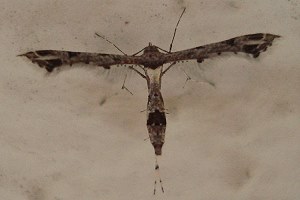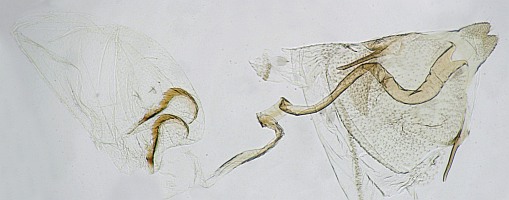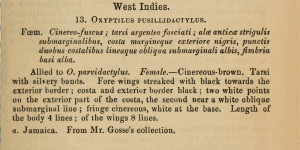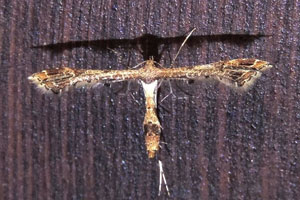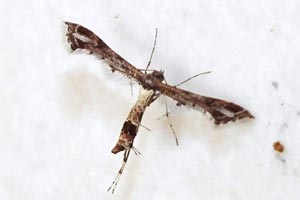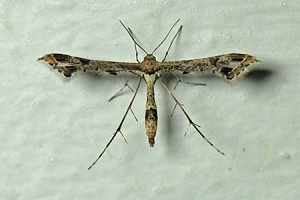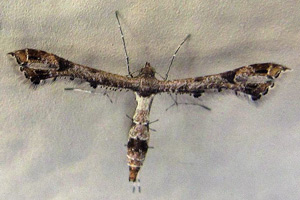

 +41Kontinente:EUASAFNAMAKISAOC
+41Kontinente:EUASAFNAMAKISAOC1. Lebendfotos
1.1. Falter
2. Diagnose
2.1. Genitalien
2.1.1. Weibchen
2.2. Erstbeschreibung
3. Biologie
3.1. Nahrung der Raupe
- [Verbenaceae:] Lantana camara (Wandelröschen)
- [Verbenaceae:] Lantana involucrata ?
- [Verbenaceae:] Lantana peduncularis ?
- [Verbenaceae:] Lantana montevidensis ?
- [Verbenaceae:] Lippia alba ? (Anisverbene ?)
- [Verbenaceae:] Phyla lanceolata ?
Schon Amsel (1951) fand seine als "Platyptilia lantanadactyla Amsel, 1951" beschriebenen Tiere als Raupe in Blütenständen von Wandelröschen in Nordafrika. Die Art scheint streng an diese Pflanze gebunden zu sein. Da die Pflanze ursprünglich in Mittelamerika beheimatet war, ist es nicht verwunderlich, dass auch die Erstbeschreibung des Falters von dort stammt.
Außereuropäische Angaben zu Nicht-Verbenaceae (Euphorbiaceae: Caperonia palustris, Lamiaceae: Mentha spicata, Lentibulariaceae: Utricularia sp.) sind wenig glaubhaft. Bella & Marchese (2007: 74) schrieben: "The Sicilian specimens were found on the blooms of Lantana camara and L. montevidensis; both species are frequently used in urban green areas because they combine remarkable cultural re[s]sistance with a low water demand and an extraordinary variety of colours of the flowers." - Ihre Funde waren Falter- nicht Raupenfunde ! Aber wahrscheinlich wird Lantana montevidensis auf Sizilien auch tatsächlich belegt. Jene Autoren erwähnen aus der außereuropäischen Literatur noch Lantana involucrata, Lantana peduncularis, Lippa alba [recte: Lippia alba] und Phyla lanceolata - Verbenaceae, die passen könnten, zu denen ich die Primärliteratur aber noch nicht kenne. In Europa spielen gepflanzte Lantana camara sicher die zentrale Rolle für die Etablierung dieses Falters.
(Autor: Erwin Rennwald)
4. Weitere Informationen
4.1. Abweichende Schreibweisen
- Lantanophaga pusillidactyla
4.2. Andere Kombinationen
- Oxyptilus pusillidactylus Walker, 1864 [Originalkombination]
4.3. Synonyme
- Platyptilia tecnidion Zeller, 1877
- Platyptilia hemimetra Meyrick, 1886
- Platyptilia lantana Busck, 1914
- Platyptilia lantanadactyla Amsel, 1951
4.4. Faunistik
Die Art wurde von "Jamaica" (Jamaika) beschrieben.
Amsel (1951) fand im Herbst 1949 in Rabat, der Hauptstadt von Marokko, Raupen in den Blütenstanden von Wandelröschen (Lantana camara). Die daraus vom 19. Oktober - 24. Dezember 1949 schlüpfenden Falter beschrieb er - an die Nahrungspflanze denkend - als "Platyptilia lantanadactyla". Dabei übersah er, dass das Wandelröschen ursprünglich gar nicht in Nordafrika vorkam, sondern aus Mittelamerika und dem Süden Nordamerikas stammte. Und tatsächlich war die Art von dort längst beschrieben! Locus typicus von Oxyptilus pusillidactylus Walker, 1864 ist "Jamaica" (Jamaika). Das Wandelröschen war schon lange als Parkpflanze beliebt und ist längst weltweit verschleppt - so eben auch in Nordafrika oder auf den Kanaren, wo es den zugehörigen Falter auch gibt. Die ersten Nachweise vom europäischen Festland stammen dann von 1997 aus Süd-Spanien.
Agius (2017) meldet die Erstfunde für Malta und fasst den bisherigen Kenntnisstand zusammen: "The species is naturally found throughout Mexico and the Caribbean. In Europe and the Mediterranean area, until 1996 L. pusillidactylus was only known from Morocco, Madeira and the Canary Islands however, through some Spanish records, in 1997 it was recorded for the first time from mainland Europe (King, 2000). A few years later, the species was recorded from mainland Italy (Bella & Marchese, 2007), from Sicily (D’Urso et al., 2008) and from Portugal (Corley et al., 2008). Most probably L. pusillidactylus was introduced in various countries with the importation of Lantana plants." Agius (2017) übersah in seiner Zusammenstellung die Beobachtungen aus Südfrankreich, über die Varenne & Billi (2008) schrieben: "Ce petit ptérophore à vaste répartition tropicale est toujours présent dans les Alpes-Maritimes (observé en automne 2005, 2006 et 2007 à Eze et au Cap Ferrat, présent dans Nice même, en janvier) mais on ne constate pas de pullulation comme en 2002. Cette espèce semble en extention sur la côte provençale : observée cette année à Fréjus-Saint-Raphaël et à La Ciotat (J. Picard, comm. pers.)." Die Angabe von Bella & Marchese (2007) bezieht sich allerdings nicht auf Festland-Italien sondern ebenfalls auf Sizilien.
Unser Falterbild 2 stammt von Sardinien. Barton (2018) meldet die Art für das Jahr 2014 erstmals auch von Zypern: "Nikokleia, 11.v.2014, adult to light, photographed (confirmed CG) (Plate 11). Lantana camara L., a given foodplant for this species, is a commonly planted ornamental and garden escape in the vicinity of the capture site."
Fazekas & Edmunds (2023: 30) berichten von ihrem Fund auf Kreta am 16. September 2014 und kommentieren: "In Europe and the Mediterranean area, until 1996 the species was only known from Morocco, Madeira, and the Canary Islands. In 1997, it was recorded for the first time in mainland Europe in Spain (King 2000). A few years later, the species was found in Italy (Bella & Marchese 2007), Sicily (D’urso et al., 2008), and Portugal (Corley et al., 2008). Most probably L. pusillidactylus was introduced in various countries with the importation of Lantana plants."
Nach [Global Biodiversity Information Facility] kommt die Art in Australien, USA, Portugal, Bahamas, Frankreich, Indien, Hongkong, Neuseeland, Mexiko, Griechenland, Spanien, Bermuda, Brasilien, Zypern, Indonesien, Réunion, Argentinien, Guadeloupe, Sri Lanka, Martinique, Malaysia, Neukaledonien, Puerto Rico, Swasiland, Südafrika, Sambia und Simbabwe vor.
(Autoren: Erwin Rennwald und Michel Kettner)
4.5. Literatur
- Agius, J. (2017): Lantanophaga pusillidactylus (Walker, 1864) new to the Maltese Islands (Lepidoptera: Pterophoridae). — SHILAP Revista de Lepidopterología 45 (178): 259-261. [PDF auf redalyc.org] bzw. [zum PDF-Download auf researchgate.net]
- Barton, I. (2018): A second contribution to the Lepidopteran fauna of Cyprus, presenting new records for 48 taxa from 17 families. — The Entomologist’s Record and Journal of Variation 130: 29-39.
- Bella, S. & G. Marchese (2007): First record of Lantanophaga pusillidactylus (Walker, 1864) for the Italian fauna (Lepidoptera Pterophoridae). — Bollettino di Zoologia agraria e di Bachicoltura, Ser. II, 39 (1): 71-74. [zum PDF-Download auf researchgate.net]
- Demetriou, J., Kazilas, C., Koutsoukos, E. & K. Kalaentzis (2020): A new tropical invader in Greece: The lantana plume moth Lantanophaga pusillidactylus (Lepidoptera: Pterophoridae). — Entomologica hellenica 29: 1-7. [PDF auf ejournals.epublishing.ekt.gr] bzw. [zum PDF-Download auf researchgate.net]
- Fazekas, I. & H. Edmunds (2023): New records of Alucitidae and Pterophoridae species from Crete (Lepidoptera). — Lepidopterologica Hungarica, 19 (1): 25–36. [PDF auf researchgate.net]
- King, G.E. (2000): Contribution to knowledge on the family Pterophoridae in Spain: Lantanophaga pusillidactyla (Walker, 1864) a new species for Spain and for Europe (Lepidoptera: Pterophoridae). — SHILAP Revista de lepidopterología, 28: 341–343. [Sekundärzitat]
- Varenne, T. & F. Billi (2008): Flux migratoire ou indigénat discret ? (Lep. Tineidae, Blastobasidae, Cosmopterigidae, Elachistidae, Gelechiidae, Pterophoridae, Pyralidae, Crambidae, Geometridae, Noctuidae, Nolidae). — Oreina 3: 9-13. [PDF auf oreina.org]
- Erstbeschreibung: Walker, F. (1864): List of the Specimens of Lepidopterous Insects in the Collection of the British Museum 30: 837-1096. London.









































